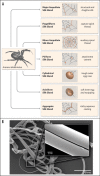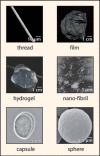The elaborate structure of spider silk: structure and function of a natural high performance fiber
- PMID: 19221522
- PMCID: PMC2658765
- DOI: 10.4161/pri.2.4.7490
The elaborate structure of spider silk: structure and function of a natural high performance fiber
Abstract
Biomaterials, having evolved over millions of years, often exceed man-made materials in their properties. Spider silk is one outstanding fibrous biomaterial which consists almost entirely of large proteins. Silk fibers have tensile strengths comparable to steel and some silks are nearly as elastic as rubber on a weight to weight basis. In combining these two properties, silks reveal a toughness that is two to three times that of synthetic fibers like Nylon or Kevlar. Spider silk is also antimicrobial, hypoallergenic and completely biodegradable. This article focuses on the structure-function relationship of the characterized highly repetitive spider silk spidroins and their conformational conversion from solution into fibers. Such knowedge is of crucial importance to understanding the intrinsic properties of spider silk and to get insight into the sophisticated assembly processes of silk proteins. This review further outlines recent progress in recombinant production of spider silk proteins and their assembly into distinct polymer materials as a basis for novel products.
Figures





Similar articles
-
Bioprospecting finds the toughest biological material: extraordinary silk from a giant riverine orb spider.PLoS One. 2010 Sep 16;5(9):e11234. doi: 10.1371/journal.pone.0011234. PLoS One. 2010. PMID: 20856804 Free PMC article.
-
High-strength and ultra-tough supramolecular polyamide spider silk fibers assembled via specific covalent and reversible hydrogen bonds.Acta Biomater. 2024 Mar 1;176:190-200. doi: 10.1016/j.actbio.2024.01.004. Epub 2024 Jan 9. Acta Biomater. 2024. PMID: 38199426
-
Spider silk: understanding the structure-function relationship of a natural fiber.Prog Mol Biol Transl Sci. 2011;103:131-85. doi: 10.1016/B978-0-12-415906-8.00007-8. Prog Mol Biol Transl Sci. 2011. PMID: 21999996 Review.
-
Spider silk: from soluble protein to extraordinary fiber.Angew Chem Int Ed Engl. 2009;48(20):3584-96. doi: 10.1002/anie.200803341. Angew Chem Int Ed Engl. 2009. PMID: 19212993 Review.
-
Spider silks from plants - a challenge to create native-sized spidroins.Biotechnol J. 2013 Oct;8(10):1183-92. doi: 10.1002/biot.201300204. Biotechnol J. 2013. PMID: 24092675 Review.
Cited by
-
Recombinant Spider Silk: Promises and Bottlenecks.Front Bioeng Biotechnol. 2022 Mar 8;10:835637. doi: 10.3389/fbioe.2022.835637. eCollection 2022. Front Bioeng Biotechnol. 2022. PMID: 35350182 Free PMC article. Review.
-
Silk Fibroin-Based Biomaterials for Biomedical Applications: A Review.Polymers (Basel). 2019 Nov 24;11(12):1933. doi: 10.3390/polym11121933. Polymers (Basel). 2019. PMID: 31771251 Free PMC article. Review.
-
The myth of antibiotic spider silk.iScience. 2021 Oct 5;24(10):103125. doi: 10.1016/j.isci.2021.103125. eCollection 2021 Oct 22. iScience. 2021. PMID: 34755083 Free PMC article.
-
Characterization of the genome and silk-gland transcriptomes of Darwin's bark spider (Caerostris darwini).PLoS One. 2022 Jun 6;17(6):e0268660. doi: 10.1371/journal.pone.0268660. eCollection 2022. PLoS One. 2022. PMID: 35666730 Free PMC article.
-
Infection Responsive Smart Delivery of Antibiotics Using Recombinant Spider Silk Nanospheres.Pharmaceutics. 2021 Aug 28;13(9):1358. doi: 10.3390/pharmaceutics13091358. Pharmaceutics. 2021. PMID: 34575434 Free PMC article.
References
-
- Gerritsen VB. An airbus could tiptoe on spider silk. Protein Spotlight. 2000;24:1–2.
-
- Kaplan D, Adams WW, Farmer B, Viney C. Silk polymers: material science and biotechnology. 1st ed. Washington DC: ACS Symposium Series; 1993.
-
- Fraser RD, MacRae TP. Conformation in Fibrous Proteins. 1st ed. New York: Academic Press; 1973.
-
- Vollrath F. Strength and structure of spiders' silks. J Biotechnol. 2000;74:67–83. - PubMed
-
- Nentwig W. Why do only certain insects escape from a spider's web? Oecologica. 1982;53:412–417. - PubMed
Publication types
MeSH terms
Substances
LinkOut - more resources
Full Text Sources
Other Literature Sources
